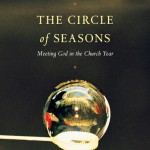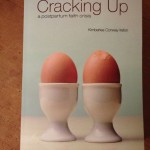I almost didn’t go in. Susan, on the other hand, immediately stepped across the threshold, knelt on one knee, crossed herself, and disappeared down the center aisle, out of my sight.
The Chapel of Perpetual Adoration was on her list of Places To Go before I returned home the next day. I’m not Catholic. Neither is she, anymore. But “Perpetual adoration, Kimberlee!” she exclaimed.
Twenty-four hours a day, seven days a week, two people sit or kneel in that chapel to pray before the Blessed Sacrament for the needs of the world. A worthy—even saintly—endeavor. Not being Catholic, I don’t hold the consecrated bread and wine in quite so much reverence. Still, I’m mystical enough to agree with Flannery O’Connor who once sniffed, “If it’s just a symbol, the hell with it.” The bread and wine, somehow, are the Real Presence of Christ: the bread, His body; the wine, His blood. I believe this. So why was I still outside the door?
Fear of the unknown? Fear of looking the bumbling interloper that I was? Fuzzy Eucharistic theology? I didn’t know. I wasn’t analyzing my emotions. I was just feeling them—and berating myself for a silly coward, which did the trick. I would not hover cravenly on the doorstep. I went in.
But I kept my eyes on the floor. Kneel. Cross myself. Stand. Walk. Make no eye contact. Make no sound. I slipped into the last pew—not that it mattered much. There were only five. The chapel would hold maybe 30 people. Once I was seated then, and only then, did I look up.
And my jaw dropped. There before me in all its hideous glory was Kitsch-with-a-capital-K. Not the evangelical kitsch that I’ve long become inured to: you know, stuffed bears holding hearts that say “Jesus Loves You,” posters of nature scenes with an Uplifting Bible Verse written across them in cursive script, Thomas Kinkade paintings. No, this outclassed Thomas Kinkade by a host of Precious Moments angels.
The monstrance (which holds the Blessed Sacrament) was a spiky gold monstrosity nestled in a white satin box, open side facing out, so chapel-sitters could see it in all its spiny gilded glory.
Beside the satin-boxed monstrance were garishly painted plaster angels with gold wings and an equally garish Holy Family. Baskets of flowers were strewn willy-nilly on the floor and on small platforms of varying heights. Beneath the clunky arrangements of carnations and baby’s breath, the platforms were draped in acres of patterned pink, green, and blue fabric, as if an Easter egg factory had exploded and all the bits of colored plastic had landed here. The crucifix was wrapped in gaudy gold ribbon tied with a gaudier gold bow.
As I sat gobsmacked staring at this spectacle, I couldn’t help contrasting it with the Trappist monastery Susan and I had visited the day before: unadorned stone walls, wooden benches, a simple wood altar with only a candle and an icon of Mary and Jesus beside it, and above it the lamp of the Presence suspended on a thin chain from the high wood ceiling. That was all: simple, spare, even austere—and beautiful. So beautiful that I wept. A thin place, the Celts would have called it, the Holy so near I felt I could reach out and touch it. Or rather, that it was reaching out and touching me. Tears of longing had coursed down my cheeks.
Now, however, in the Chapel of Perpetual Bad Taste, I was laughing. Silently, of course, my shoulders shaking with noiseless mirth. Good thing I was in the last row. No one could see. I imagined God chuckling, too—after all, He’s a tasteful guy—and shaking His head, our eyes meeting in mutual horror and amusement. How, I wondered, could anyone pray here? Surrounded by so much vulgarity?
And then, just as I was feeling perfectly superior to the poor clueless rubes who decorated this joint, quite suddenly—
Clarity. Conviction.
I felt like a character in a Flannery O’Connor story, suddenly slapped in the face with the ugly reality of myself: arrogant, proud, condescending…and spiritually impoverished.
In all my urban sophistication, I realized, I couldn’t hold a candle to the blue-haired old lady and the stoop-shouldered gentleman who knelt before the Blessed Sacrament and interceded on behalf of God’s children.
My refined sensibilities were too coarse to perceive the truth, until that moment of blinding sight: God did not see what I saw, nor was He laughing with me at these people. God’s Heart—the Heart of Love and Beauty that is the pulse of the universe—delights in this place. For here, His faithful people gather hour after hour, day after day, year in and year out, to praise Him, petition Him, pour out their hearts to Him in love and confidence and gratitude.
These past weeks, while the rest of us have been feeling overwhelmed by the world gone mad, that blue-haired old woman and the stoop-shouldered gentleman and all the other praying people in that place have gathered to worship and adore and trust and pray, to lift up the needs of the broken and needy and hurting every hour of every day. Their prayers—faithful, humble, invisible to all but God—transform a tacky, gaudy, kitschy little chapel into a paradise of praise, a thin place, a place of beauty and love so deep only Beauty and Love can behold it.
Take my eyes, Lord,
take and blind me
Till I see as Thou dost see.
Love and Beauty
are Thy heartbeat—
Place Thy clear-eyed heart in me.
Photo by Denis-Carl Robidoux, Creative Commons via Flickr.


